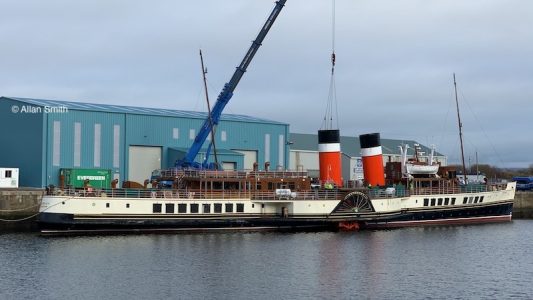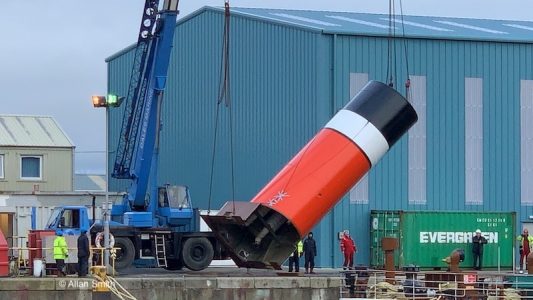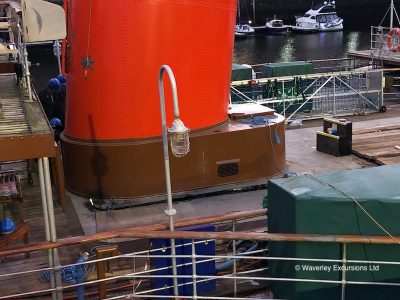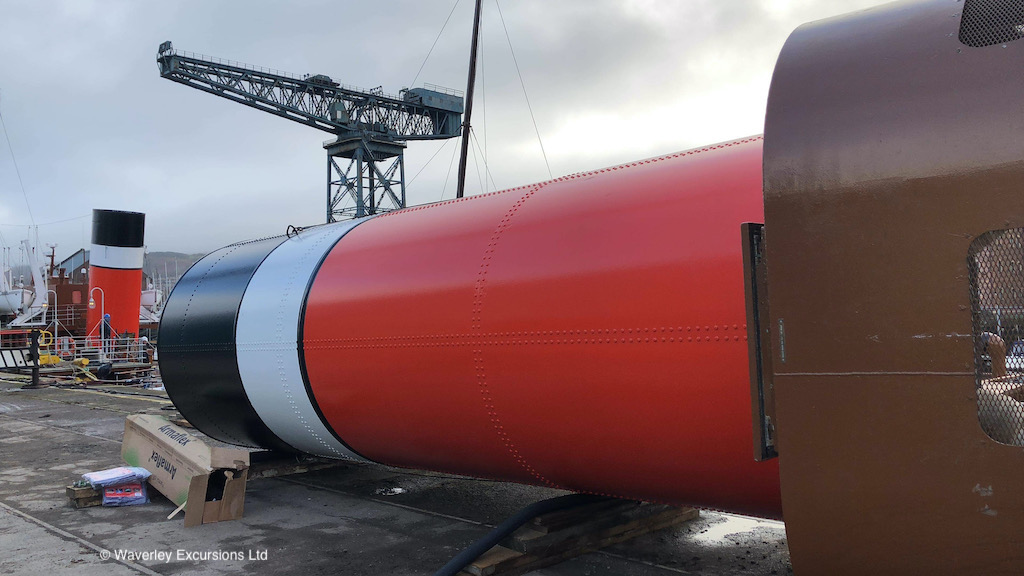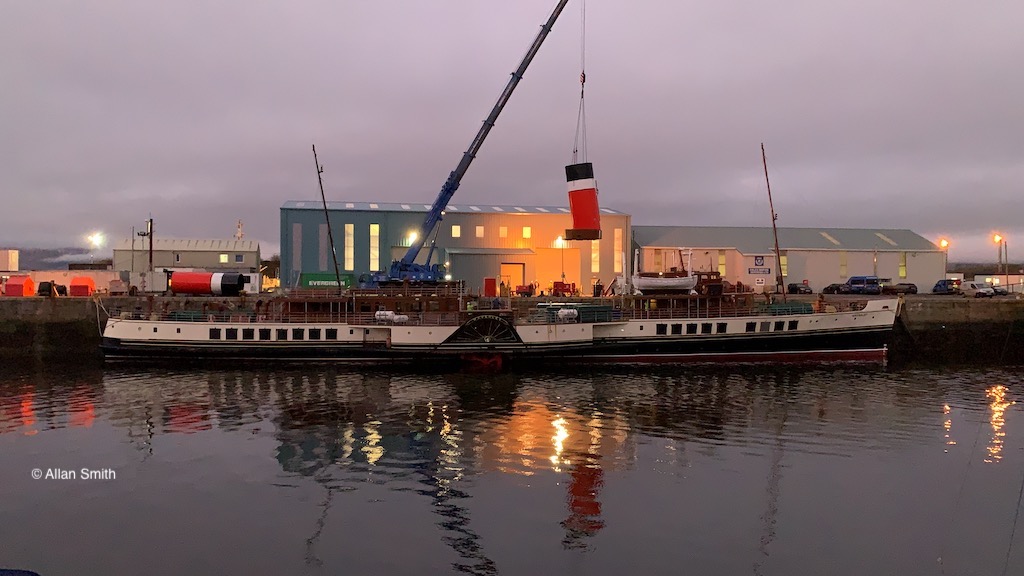
Waverley in James Watt Dock, Greenock, on Wednesday 22 January — with Caledonian Isles and Hebridean Princess
Waverley’s reboilering is underway — but to facilitate the necessary ‘open heart surgery’ below decks, the paddler’s funnels first had to be removed. Allan Smith was at the dockside in Greenock on 22 January to observe the unusual proceedings.
It was a fine morning at James Watt Dock last Wednesday, with the sun shining brightly on Waverley’s red, white and black funnels for one last time before their temporary removal.
At around 11am a small number of enthusiasts and supporters gathered on the south side of the dock, eagerly waiting for work to start. Situated between Loch Ranza and Caledonian Isles on the north side, the paddler made a fine sight — as did the Arran ferry, gleaming with fresh paint after her annual drydocking. Work was still going on: both vehicle ramps were opened and closed several times during the morning, and the bow visor was also receiving attention. Nearby the fishing vessel Dillon Owen was being dismantled at speed.
Shortly after 11.15 a crane swung round towards Waverley’s aft funnel and a cherry picker manoeuvred two men to the top of the funnel. The crane was then attached to four points on the top of the funnel. As soon as the crane took up the slack on the funnel, the cutting and grinding began.
This process took time, necessitating a long wait for onlookers.
The aft funnel contains the fuelling station, which does not require alteration and is being left intact — which explains why the funnel was cut in such a way as to leave the station in place. And so, when the funnel was eventually lifted, it looked as if the aft section of the base was missing.
At long last, by 13.30 the cutters and grinders had finished their work and the aft funnel began to tilt. As soon as the funnel was free, the crane slowly lifted it high in the air — prompting speculation among the spectators as to where it would be deposited.
Slowly it was manoeuvred towards the quayside at Waverley’s stern and held a few feet from the ground. After some discussions, a second crane arrived and was connected to the base of the funnel. Between them, the two cranes brought the red, white and black lum to a horizontal position in the air.
Wooden blocks with a rubber topping were then put in place on the quayside and the funnel was laid to rest on the ground.
The forward funnel is slightly weightier than its aft counterpart. It contains the exhausts from the boilers while the aft contains those for the generators. The safety valve exhaust also travels up the forward one.
With the boilers soon to be removed, the only thing that should remain in the boiler room are Waverley’s fuel tanks.
With one funnel down and one to go, there was a lull in activity. This was of little concern to spectators as Loch Ranza was preparing to sail.
With the gangway removed and ropes all clear, the vessel — one of the original ‘Loch’ class quartet of 1986 — pushed off the quay using her Voith units and lined up with the dock entrance. The vessel glided ahead and left the dock for her passage down the Firth of Clyde.
After roughly an hour’s break it was the turn of Waverley’s forward funnel to receive the attentions of the main crane. It duly underwent the same removal procedure as before, using four connection points. In the fading light, sparks became visible as the cutting work proceeded. With no fuelling station in the forward funnel, the entire base could be removed.
Eventually the final piece was cut and the funnel (still with steam whistle attached) ‘popped’ as the weight transferred to the crane. Once more a funnel ascended into the sky, but the descending late afternoon gloom made photography difficult.
The second crane, which had meantime been removing sections of Dillon Owen, now rushed back to assist its larger counterpart.
Just as before, they lowered the funnel horizontally onto the quay, this time opposite the forward end of the vessel.
For a while Waverley will be ‘funnel free’. We now await the next step — the removal of the old boilers and generators, and the installation of new ones.
Here’s hoping for an excellent 2020 season.
Waverley funnel dimensions:
Height (incl. casing) 24′ 8″
Height of casing 3′ 0″
Funnels are roughly oval
Length of cross-section 9′ 6″
Width of cross-section 7′ 6″
Circumference 26′ 9″
CRSC thanks Allan Smith, Ken Mills and Waverley Excursions Ltd for the use of their copyright photographs, and Robert Marshall for data on Waverley’s funnels.
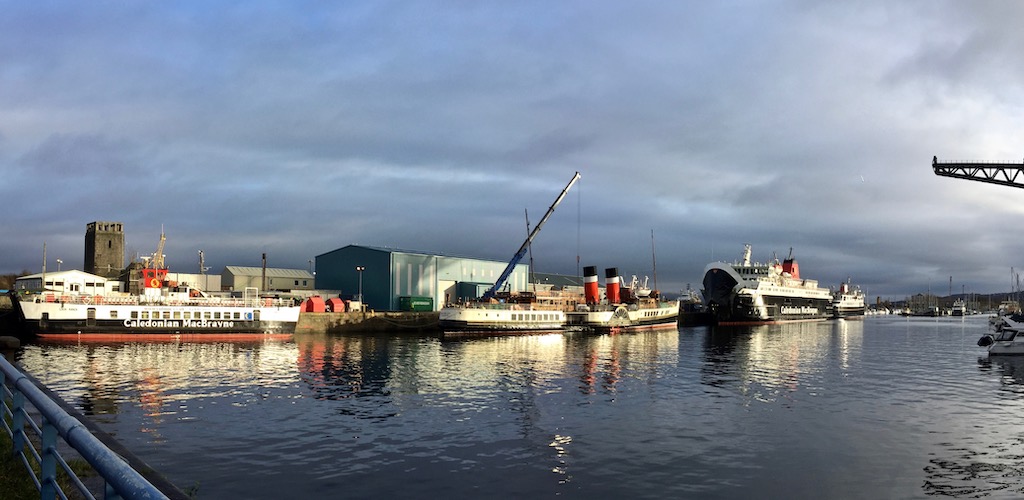
A peaceful James Watt Dock, Greenock, on 21 January, the day before work began on removing Waverley’s funnels
Published on 26 January 2020












